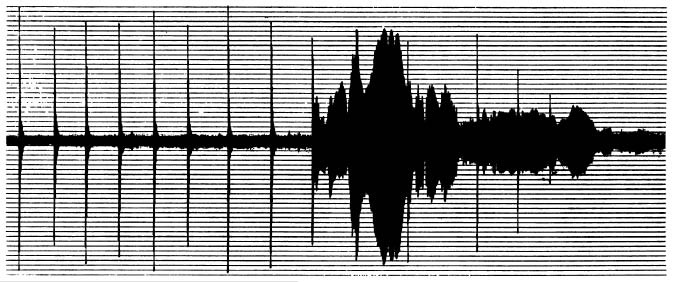Vocalization of Bottlenose Dolphins
Helen Magee, Biology 342 Fall 2007
Mechanism
How Dolphins Can Produce Multiple Sounds at Once
One really interesting aspect of the mechanism of dolphin vocalization is how they can produce multiple sounds at the same time. For example, dolphins have been observed to produce both clicks and whistles simultaneously. Figure 1 shows the amplitude recording of a dolphin making both the click and whistle sounds at the same time. In this graph, the spikes at regular intervals represent the clicks, which are being produced at a rate of 30 clicks per a second. The portion where the amplitude is changing rapidly is the whistle. The clicks are still present in this part of the graph, as they are being produced at the same time as the whistle. In this example, the dolphin stopped making the clicking sound as it continued to whistle, but in Figure 2 the dolphin produced two whistles within a longer series of clicks.
Figure 1: Whistle During Series of Clicks(6)

Figure 2: Two Whistles Within a Series of Clicks (6)

Dolphins are able to do this because they have two separate systems that allow them to emit sounds. When dolphins make the clickimg sounds, it shocks the resonant frequencies and harmonics of cavities in the head of the dolphin, such as variable sacs, fixed sinuses and the fixed nasal passage. The whistle sound is produced from the vibration of these cavities. The clicking sound can also be produced from these cavities, at the same time as the whistle sound(6). The frequencies of both the whistles and the clicks can change, because the cavities change in size and shape.
Producing Sound Out of the Water
As well as vocalizing under water, dolphins can also produce sounds in the air. To create the whistle sound outside of water, the dolphin brings its blowhole above the surface of the water, and emits a whistle sound through its blowhole. Unlike when it produces this same sound under water, when the whistle sound is made above water the sound is much quieter and small bubbles are also produced (6). Other sounds that the dolphin makes, including clicks, blats, squawks and quacks, are internally produced sounds that the dolphin releases through its blowhole into the air(6).